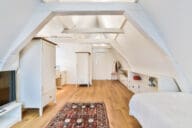What Is a Mother-in-Law Suite, and Should I Consider Adding One?
- Published on
- 9 min read
-
 Emily Hines, Contributing AuthorClose
Emily Hines, Contributing AuthorClose Emily Hines Contributing Author
Emily Hines Contributing AuthorEmily Hines is a writer and content strategist with 8 years of professional experience focusing on architecture, travel, and culture and contributes to a variety of publications including USA Today, TimeOut, and Craftbeer.com. She holds a Masters in Historic Preservation from the University of Georgia and is currently based in Marquette, Michigan where she writes a monthly travel blog, drinks craft beer, and skis.
-
 Jedda Fernandez, Associate EditorClose
Jedda Fernandez, Associate EditorClose Jedda Fernandez Associate Editor
Jedda Fernandez Associate EditorJedda Fernandez is an associate editor for HomeLight's Resource Centers with more than five years of editorial experience in the real estate industry.
If mom isn’t happy, no one is. You’ve heard it before, but it bears repeating — especially when it comes to a certain mother-in-law moving in.
Plenty of households are cohabiting across several generations, by choice or by necessity, and that’s generated more interest in the home additions or renovations known as mother-in-law suites. In fact, in 2024, 14% of home buyers bought a multi-generational home, the top reasons being to take care of or spend more time with aging parents, to make room for children over 18 moving back in, and for cost savings.
But what exactly is a mother-in-law suite?
All jokes aside, a mother-in-law-suite is a private living area within a home or property, designed as a separate living space to provide comfort and privacy for the occupant. These dwellings vary widely depending on the needs of the resident, but they typically include at least one bedroom and bathroom.
They can also earn a few creature comforts of home, such as a separate entrance, kitchen, and living room. These conveniences are a big bonus, especially if the living situation is going to be long-term. Lauren Reinhardt of Judd Builders in Asheville, North Carolina, says, “Many of the suites we build are configured in lower levels of homes that have walk-out basements with an exterior door.” Reinhardt adds that most of them include a bedroom, bathroom, kitchen or kitchenette, and a small living space.”
How are these suites configured or added?
Some mother-in-law suites are accessory dwelling units (ADUs) or “granny flats,” an outbuilding with electricity and plumbing that’s located on your property. If you search Pinterest for these, you’ll find more inspiration than you need — glamorous she-sheds, rustic man caves, and guest rooms with hotel-like amenities.
In Portland, Oregon, Chad Ruhoff of East Avenue Design+Build specializes in ADUs in the backyard, built on-site, with a full kitchen, bath, and bedroom. Portland has a 1,000-square-foot maximum for ADUs (previously 800). One of the most common ways to add a mother-in-law suite is to renovate an underutilized space in the home. Far more common are families who have renovated their homes to suit aging parents or adult children.
Oren Farkash, CEO and Owner of South Land Remodeling Inc., agrees. “Utilizing the garage space is the ideal scenario” because a garage is typically either off to one side of the existing home or detached completely. Comfort and privacy are what clients are looking for in mother-in-law suites,” and reconfiguring the garage meets both of those needs.
In this example, Farkash says, “We utilized the garage space and added more square footage to create a bigger space for the client’s needs.” This mother-in-law probably appreciated the additional space accommodating a living room, kitchen, and closet in addition to the bedroom and bathroom.

In other projects where a detached garage isn’t available, Farkash looks for other existing rooms that may have potential for a mother-in-law suite.
“Sometimes we need to get creative and use an existing bedroom that is somewhat private, preferably in the back of the house. This gives more options with the design and reduces disturbance of other rooms. In addition, a bedroom in the back of a home gives the option to expand into the backyard if more square footage is needed for amenities like a walk-in closet or spacious bathroom.”
Not all mother-in-law suites are additions. Top real estate agent Lori Adams in Buffalo, New York, who has almost two decades of experience, says she worked with two sisters who built a home with a mother-in-law suite on the side. “They knew they wanted to live together but needed their own living spaces.”
What is the appeal of a mother-in-law suite?
There are myriad reasons to create a mother-in-law suite on your property. One of the most popular is intergenerational living, also known as living with your mother-in-law. In fact, 27% of buyers who bought a multi-generational home did so to care for an aging parent, 19% did so to accommodate children over 18 who were moving back in, and another 19% wanted to spend more time with aging parents. Another big reason, at 22%, is to save money.
Grandparents may even enjoy the role of on-call babysitter to spend more time with grandchildren.
Even builders are offering specific floor plans to accommodate multiple generations under one roof. For families who can afford it, major homebuilders are now offering “multigenerational” floor plans that make space for three or more generations.
Adams says of the trend, “I’ve sold at least 12 houses that had a mother-in-law suite to clients that are looking to house a family member. One recent client was looking for a home with a mother-in-law suite to accommodate her mother with kidney disease and provide in-home care because it was cheaper than finding a home for the mother to live in on her own.”
If you work from home but are in dire need of some separation between home life and work life, a mother-in-law suite may be perfect for you. One of the best things you can do for yourself if you work from home is to make a designated workspace. A mother-in-law suite can give you a separate workspace without actually leaving your house. And when you’re done for the day, turn out the lights and shut the door on your work email — and the rest of the to-do list, literally.
Depending on where you live, a mother-in-law suite could earn you some extra cash by listing it as a vacation rental on VRBO or Airbnb. If you live in a popular vacation destination, or if you live in an area with not many hotel options, that mother-in-law suite may end up paying for itself (and then some). When it isn’t rented, use the additional space for family and friends visiting.
Ruhoff’s Portland client built their ADU as a guest house but lists it on Airbnb to generate supplemental income when they’re not using it. “It had an occupancy rate of 91% in 2019 for the nights available and generated more than $15,000,” Ruhoff notes. But before you go all in, check your local ordinances to make sure short-term rentals are legal in your area.
Does a mother-in-law suite add property value?
If you decide to add a mother-in-law suite for an elderly parent or as a sleek home office, when you go to sell your home, you’ll find families looking for homes like these, and you may be pleasantly surprised by the return on investment. HomeLight’s survey reveals that 38% of agents consider home office spaces or dedicated remote work areas as the strongest selling point in their markets in 2024.
Adams recalls, “I listed a house with a one-bedroom mother-in-law suite recently, at $145,000. We ended up with 14 offers and it sold for $191,000.”
OK, I’m sold. How would I add a mother-in-law suite?
Before you get too excited about adding a mother-in-law suite to accommodate your office/yoga studio, she-shed/office, find out if it is legal. City and municipal zoning ordinances and permitting requirements can get in the way of this type of construction or renovation.
Size does matter. Ruhoff notes, “Mother-in-law suites or accessory dwelling units range in size from 300 to 1,000 square feet. But there can be city regulations to consider.” For instance, the city of Portland previously had an 800-square-foot maximum before it was updated to 1,000.
When you’re planning your design with a professional, think about your home and existing infrastructure that might allow for an addition like this and would require the fewest structural adjustments. Is there already a half-bath nearby that can be expanded? If you’re building to accommodate an elderly family member, which area of your property offers the easiest access? For example, an upstairs attic space might be too difficult to access.
Budgets vary widely depending on the taste and needs of a client. A basic renovation of a garage will cost approximately $7,000 to $30,000, whereas homeowners typically spend $5,000 to $35,000 for converting a walk-out basement into a livable suite. The investment for adding on a second master suite can cost anywhere between $8,600 to upwards of $100,000, while you can expect to spend up to $21,600 on a new accessory dwelling unit. For top-of-the-line finishes in a garage remodel turned mother-in-law suite, Ruhoff recalls a recent client who spent “$130,000 on amenities like a custom Murphy bed and designer tile.”
When discussing budgets with his clients, Ruhoff asks a lot of questions to hone in on the primary purpose of adding a mother-in-law suite: “How are they going to use it? Are they looking for rental income? Do they want a workspace with no separate bedroom? Or do they want to move a grandparent closer to the family?”
Once he knows the client’s goals, he has a clearer picture of how to move forward.
Costs can be managed by both design and material selection. And kitchens can be a major cost-driver. Ruhoff says a former client “spent $15,000 more on high-end appliances in the full kitchen because the unit was designed to be an income generator.”
If you don’t need a full kitchen, you’ll save money there. Ruhoff says, “A kitchenette, a sink, a two-burner stove, microwave, and small fridge will get the job done.” Another client wanted to create a space for her mom, but “thinks Mom will eat with the rest of the family most nights, so we designed a smaller kitchen space.”
With zoning regulations and navigating intergenerational living, making the decision to add a mother-in-law suite is not an easy one. But depending on your family’s needs, it could provide your home with added value. If you do decide to move forward, make sure you work with a licensed professional that can create the sleek office space you’ve always wanted or a cozy place for your mother-in-law to call home.
Header Image Source: (Artazum / Shutterstock)
- "How Much Does a Home Addition Cost? [2025 Data]", Angi (January 2025)
- "Airbnb Will Change The Way We Travel In 2025", Forbes (January 2025)
- "2024 Home Buyers and Sellers Generational Trends Report", National Association of REALTORS® (March 2024)
- "Portland’s ADU Rules: A Complete Guide (Updated 2025)", Lamont Bros. Design & Construction (January 2025)




